At a recent Women in Family Business Peer Group at the Conway Center for Family Business, we discussed how important it is for women in family owned businesses to know how to read financial statements. There is no way for a woman to take over leadership if she shies away from the financial side of the business and doesn’t take the time to understand and analyze the numbers. Feeling overwhelmed with all this information is a normal response, but an excellent resource that offers free college course information including accounting is available at iTunes U.
Here are a few key areas of the financial report:
Balance sheet – shows what a company owns and what it owes at a fixed point in time. It provides detailed information about the company’s assets, liabilities and shareholders’ equity.
Assets – things the company owns that have value…cash, money owed to the company, physical property, and some things that can’t be touched like a patent. Assets are generally listed on how quickly they will be converted into cash (so cash would be on the top).
Liabilities – things the company owes to others…money borrowed, rent, payroll, taxes, and other obligations.
Shareholders’ Equity — sometimes called capital or net worth. The money leftover …after Assets minus Liabilities = Shareholders’ Equity
Income Statements – shows how much money a company made and spent over a period of time. This report shows how much revenue the company earned and the income statement also shows the costs and expenses associated with earning that revenue. The bottom of the statement usually shows the net earnings or losses revealing how much the company earned or lost over the period.
Think of the Income Statement is a flight of stairs. You start at the top with the total amount of money brought in from sales or services. For every step down, there is a deduction…for certain costs and operating expenses associated with the earnings. At the bottom of the stairs, after deducting all the expenses, you are left with how much the company actually earned or lost, aka…”the bottom line.”
Cash Flow Statements — show the exchange of money between the company and the outside world over a period of time. These statements report a company’s inflows and outflows of cash. Obviously important because a company needs to have enough cash on hand to pay its expenses and purchase assets. While the Income Statement can tell you whether a company made a profit, the cash flow statement can tell you whether a company generated cash.
Knowing how to read financial statements is crucial to knowing your business. Reviewing this information regularly and with a critical eye allows you to recognize problems so you can act quickly. Each statement gives you a different detail and they open your eyes to potential pitfalls or alternatives you can explore when making decisions for your family business.
Until next time,
Bea Wolper
Emens & Wolper Law
Bea Wolper is President of the law firm of Emens & Wolper Law Firm, Columbus, Ohio, where her practice focuses on succession planning, estate planning, oil and gas law, contracts and the buying and selling of assets and businesses, with an emphasis on family-owned businesses. She is also the co-founder of the Conway Center for Family Business.

